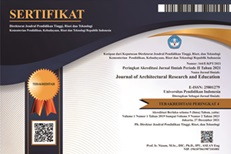THERMAL INVESTIGATION AT WONOSOBO MARKET, INDONESIA
Abstract
Thermal comfort is one of the factors influencing the success of the building as a place of human activity. Market building in Indonesia plays an essential role in trading activity. The thermal conditions of the Wonosobo market have problems in realizing the thermal comfort of building users. This research aims to investigate the thermal situation of Wonosobo Market, Indonesia. The research method uses quantitative and qualitative methods. Measurements were made using an infrared thermometer. Subjective measures were carried out on 100 respondents. The results show that the Wonosobo Market building has not been able to meet the expectations of building users. The thermal performance of the Wonosobo Market needs to be improved to comfortably accommodate the activities of building users.
Keywords
Full Text:
PDFReferences
Abdel-Rahman, W. S. M. (2020). Thermal performance optimization of parametric building envelope based on bio-mimetic inspiration. Ain Shams Engineering Journal, xxxx. https://doi.org/10.1016/j.asej.2020.07.007
Asif, A., & Zeeshan, M. (2020). Indoor temperature, relative humidity and CO2 monitoring and air exchange rates simulation utilizing system dynamics tools for naturally ventilated classrooms. Building and Environment, 180(May), 106980. https://doi.org/10.1016/j.buildenv.2020.106980
Costa, M. L., Freire, M. R., & Kiperstok, A. (2019). Strategies for thermal comfort in university buildings - The case of the faculty of architecture at the Federal University of Bahia, Brazil. Journal of Environmental Management, 239(February), 114–123. https://doi.org/10.1016/j.jenvman.2019.03.004
Feng, Y., Liu, S., Wang, J., Yang, J., Jao, Y. L., & Wang, N. (2022). Data-driven personal thermal comfort prediction: A literature review. Renewable and Sustainable Energy Reviews, 161(September 2021), 112357. https://doi.org/10.1016/j.rser.2022.112357
Gracia, A. De, Barzin, R., Fernández, C., Farid, M. M., & Cabeza, L. F. (2016). Control strategies comparison of a ventilated facade with PCM – energy savings , cost reduction and CO 2 mitigation. Energy & Buildings. https://doi.org/10.1016/j.enbuild.2016.09.007
Hermawan, H., & Prianto, E. (2018). Thermal evaluation for exposed stone house with quantitative and qualitative approach in mountainous area, Wonosobo, Indonesia. IOP Conference Series: Earth and Environmental Science, 99(1). https://doi.org/10.1088/1755-1315/99/1/012017
Hermawan, H., & Švajlenka, J. (2021). The connection between architectural elements and adaptive thermal comfort of tropical vernacular houses in mountain and beach locations. Energies, 14(21). https://doi.org/10.3390/en14217427
Hermawan, Prianto, E., & Setyowati, E. (2020). The comfort temperature for exposed stone houses and wooden houses in mountainous areas. Journal of Applied Science and Engineering, 23(4), 571–582. https://doi.org/10.6180/jase.202012_23(4).0001
Hermawan, Prianto, E., Setyowati, E., & Sunaryo. (2019). The thermal condition and comfort temperature of traditional residential houses located in mountainous tropical areas: An adaptive field study approach. International Journal on Advanced Science, Engineering and Information Technology, 9(6), 1833–1840. https://doi.org/10.18517/ijaseit.9.6.3560
Jiang, J., Wang, D., Liu, Y., Di, Y., & Liu, J. (2021). A holistic approach to the evaluation of the indoor temperature based on thermal comfort and learning performance. Building and Environment, 196, 107803. https://doi.org/10.1016/j.buildenv.2021.107803
Khovalyg, D., Kazanci, O. B., Halvorsen, H., Gundlach, I., Bahnfleth, W. P., Toftum, J., & Olesen, B. W. (2020). Critical review of standards for indoor thermal environment and air quality. Energy and Buildings, 213, 109819. https://doi.org/10.1016/j.enbuild.2020.109819
Malik, J., Bardhan, R., Hong, T., & Piette, M. A. (2020). Contextualising adaptive comfort behaviour within low-income housing of Mumbai, India. Building and Environment, 177(April), 106877. https://doi.org/10.1016/j.buildenv.2020.106877
Stamatelopoulou, A., Pyrri, I., Asimakopoulos, D. N., & Maggos, T. (2020). Indoor air quality and dustborne biocontaminants in bedrooms of toddlers in Athens, Greece. Building and Environment, 173(December 2019), 106756. https://doi.org/10.1016/j.buildenv.2020.106756
Um, C. Y., Zhang, N., Kang, K., Na, H. S., Choi, H., & Kim, T. (2022). Occupant behavior and indoor particulate concentrations in daycare centers. Science of the Total Environment, 824, 153206. https://doi.org/10.1016/j.scitotenv.2022.153206
DOI: https://doi.org/10.17509/jare.v4i2.50724
Refbacks
- There are currently no refbacks.
Copyright (c) 2023 Journal of Architectural Research and Education

This work is licensed under a Creative Commons Attribution-NonCommercial-ShareAlike 4.0 International License.

This work is licensed under a Creative Commons Attribution-ShareAlike 4.0 International License.








